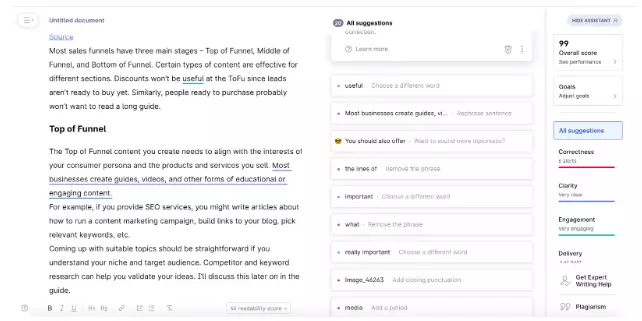We’re surrounded by content in the digital world. What makes content powerful is that it influences viewers and readers. Due to the content they consume, health blog readers may shift their diet to keto, or passive income enthusiasts may venture into crypto.
If you’re open to hosting quality content on your website, then you can also shape your target market’s minds in favor of your products or services. So, here are five steps to creating successful content for your business:
1. Make content that is related to your sales funnel
A sales funnel is how you ensure that prospects progress from not knowing your brand to making a purchase.
As a business owner, you can apply various methods (SEO, social media, or Email) to get visitors to your website. You may also create a QR code for a website to which you want to drive traffic. This can be effective for offline marketing campaigns, e.g., attaching A QR code to your site on a billboard, business card, and so on.
In all of this, there must be relevant content to take visitors through your sales funnel. Without this, you’d be losing any conversion you intend to make.

Most sales funnels have three main stages – Top of the Funnel, Middle of the Funnel, and Bottom of the Funnel.
Top of Funnel
The Top of Funnel content you create needs to align with the interests of your consumer persona and the products and services you sell. That’s why it’s essential to spend some time knowing your audience and their pain points. That could be through engaging your audience in in-person or virtual events and consumer research.
Once you know your target audience and their pain points, creating valuable ToFu content gets easier.
Most businesses use guides, videos, and other forms of educational or engaging content at this stage.
Competitor and keyword research can help you come up with suitable informational topics for your target audience.
Middle Of Funnel
MoFu content nurtures prospects and moves them further down the sales funnel, where conversions occur. Typically, it includes content like:
- Explainer videos/blogs
- Product comparison videos/blogs
- Case studies
It also includes lead generation magnets like ebooks, PDF guides, etc. If you have videos as part of the MoFu content on your site, ensure that you use a good video hosting platform.
The idea in this stage is to generate a positive brand impression, build trust and increase touchpoints with prospects.
Bottom Of Funnel
Your ToFu and MoFu serve as the introduction and getting-to-know. The purpose of your BoFu should be to drive conversions by convincing users about your products and informing them about upcoming products or significant offers.
You should also offer occasional discounts and promos here. Discounts are effective since they nurture a committed user base and entice hot leads to make a purchase.

In the above example, Zalora’s newsletter content has a strong call to action, “Pre-load your cart.” The content also highlighted some discounts from Zalora.
Note that certain types of content are effective for different sections. For instance, discounts won’t be helpful at the ToFu since leads aren’t ready to buy yet.
2. Identify potential keywords
Once you’ve created a list of ideas for specific parts of the sales funnel, you should do your keyword research.
According to a study by Semrush, 88% of marketers create content based on keyword research, while 73% do so from competitive research.
Effective SEO keyword research helps you to understand what people are searching for and create content that is likely to appear in search results.

Moz keywords result from the search term “Best Laptops to Buy”
How do you identify potential keywords?
- Create a list of potential topics you want to cover
- Research the monthly search volume.
- Determine which keywords to target based on competition.
If you’re creating content for SEO, the topics you cover should have a keyword focus. If you want to rank for the search term “Best thin and light laptops,” you may write and optimize an article around that keyword. Tools like Surfer and Clearscope can help you with that.
3. Create a captivating outline
Once you have your topic and keywords ready, you need to create the content outline.
Whether it’s in the form of a blog, podcast, or video, successful content always follows a captivating outline. An outline will allow you to:
- Determine what’s to be included in the content
- Ensure you cover the issues that your audience cares about
- Create a great piece of content faster
A good outline is important if you’re creating content for SEO. I recommend breaking a piece of content down into initial headings like the one below:

Once you have your initial outline, you can add notes about what you want to cover under each section.
You can use content creation tools like Frase, Copy.ai, or Rytr to speed up the process of creating your article outline.
4. Edit and proofread
Mistakes in an article impact people’s perceptions of your content and brand. One small mistake may drastically reduce your blog’s value.
Spend time editing and proofreading your content. I recommend using a grammar check tool such as Grammarly. Such tools are great for catching typos and other mistakes. The screenshot below nicely illustrates just why this is so important.

Ideally, you should hire an editor to review your work. Aside from proofreading for errors, editing your content also ensures consistency in your brand communication. In fact, it’s advisable to create a guide to terminology management and overall brand style. This guide should help your content writers and editors create content that perfectly aligns with the brand style you want.
The same principle of a thorough editorial review applies to videos and podcasts. It’s important to invest time in polishing your content post-production.
5. Get the word out via social media
After creating a piece of content, focus on marketing it. Share your content on social media, and try to get people talking about it.
Sites like Bored Panda are experts at social media marketing. They share blog posts and articles on their Facebook page and generate lots of organic engagement.

They also use paid ads to increase the reach of the best-performing content.
You, too, should share your company’s published blogs on social media. Share your blogs on Facebook, Twitter, and LinkedIn. This should also work for videos, podcasts, and downloadable lead magnets.
You’ll also need to use tools like Google Analytics to see how your content is doing. So you know which marketing channels are working and where you need to put more effort. With a hosting platform like Cincopa, you can access advanced video analytics features to get insight into the performance of your videos.
Wrapping up
Content is a powerful tool for shaping minds and turning people’s heads in favor of your brand.
To start content marketing, conceptualize topics for each stage in your marketing funnel. Identify keywords by determining what they’re likely to search for, and use these to inspire your topics.
Outline your content before creating it so that you stay on topic. After producing your content piece, polish it off by editing and proofreading it.
You should also market your content. Share your content on social media and promote it through email marketing, pay-per-click, and building links to your blogs. You will convert more prospects once you’ve followed all these steps. You’ll also be a brand attributed with quality output.







